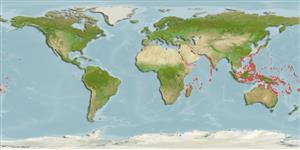Teleostei (teleosts) >
Syngnathiformes (Pipefishes and seahorses) >
Syngnathidae (Pipefishes and seahorses) > Syngnathinae
Etymology: Micrognathus: Greek, mikros = small + greek, gnathos = jaw (Ref. 45335).
Eponymy: Dr A J Anderson was a physician on the Cocos Islands who collected fish specimens. [...] (Ref. 128868), visit book page.
More on author: Bleeker.
Environment: milieu / climate zone / depth range / distribution range
Ecology
Marine; reef-associated; depth range 0 - 10 m (Ref. 48635). Tropical; 35°N - 25°S, 32°E - 167°W
Indo-Pacific: East Africa and Red Sea to Samoa, north to southern Japan, south to Tonga; Belau, to the eastern Caroline and Mariana Islands in Micronesia.
Size / Weight / Age
Maturity: Lm ? range ? - ? cm
Max length : 8.5 cm TL male/unsexed; (Ref. 48635)
Inhabits tide pools, reef flats, and shallow sand flats among algae or seagrasses to a depth of 5 m or more. Ovoviviparous (Ref. 205). The male carries the eggs in a brood pouch which is found under the tail (Ref. 205).
Life cycle and mating behavior
Maturity | Reproduction | Spawning | Eggs | Fecundity | Larvae
Male carries the eggs in a brood pouch (Ref. 205).
Myers, R.F., 1991. Micronesian reef fishes. Second Ed. Coral Graphics, Barrigada, Guam. 298 p. (Ref. 1602)
IUCN Red List Status (Ref. 130435: Version 2024-1)
Threat to humans
Harmless
Human uses
Tools
Special reports
Download XML
Internet sources
Estimates based on models
Preferred temperature (Ref.
123201): 25.1 - 29.3, mean 28.2 °C (based on 2065 cells).
Phylogenetic diversity index (Ref.
82804): PD
50 = 0.5039 [Uniqueness, from 0.5 = low to 2.0 = high].
Bayesian length-weight: a=0.00037 (0.00016 - 0.00085), b=3.18 (2.99 - 3.37), in cm total length, based on LWR estimates for this (Sub)family-body shape (Ref.
93245).
Trophic level (Ref.
69278): 3.2 ±0.5 se; based on size and trophs of closest relatives
Resilience (Ref.
120179): High, minimum population doubling time less than 15 months (Preliminary K or Fecundity.).
Fishing Vulnerability (Ref.
59153): Low vulnerability (10 of 100).
Nutrients (Ref.
124155): Calcium = 221 [118, 488] mg/100g; Iron = 1.32 [0.64, 2.38] mg/100g; Protein = 17.9 [16.6, 19.2] %; Omega3 = 0.111 [0.055, 0.236] g/100g; Selenium = 33.2 [14.0, 85.8] μg/100g; VitaminA = 65.4 [18.4, 226.9] μg/100g; Zinc = 2.57 [1.56, 3.99] mg/100g (wet weight);
